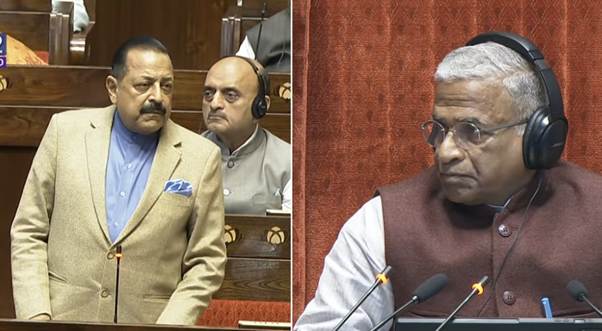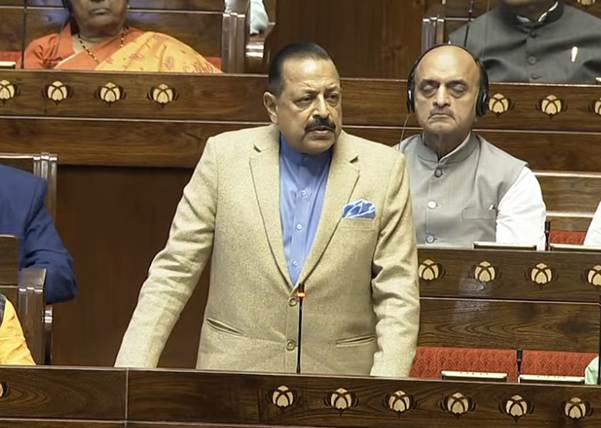Ministry of Earth Sciences
Union Minister Dr. Jitendra Singh Highlights in Rajya Sabha India's robust disaster preparedness including earthquake preparedness as well as disaster management strategies
Gujarat Disaster Management Committee was the first of its kind to be established when Sh Narendra Modi was the Chief Minister and subsequently, inspired by this, in 2005, the National Disaster Management Committee came into existence
प्रविष्टि तिथि:
13 FEB 2025 7:47PM by PIB Delhi
Union Minister Dr. Jitendra Singh, while responding to questions in the Rajya Sabha, outlined India's robust disaster preparedness including earthquake preparedness as well as disaster management strategies. He emphasized the significant progress made over the years in strengthening the nation's resilience to seismic activities, particularly in high-risk regions like Gujarat, Uttarakhand, and the Himalayan belt.

Dr. Jitendra Singh highlighted that following the Gujarat earthquakes, the Gujarat Disaster Management Committee was the first of its kind to be established when Sh Narendra Modi was the Chief Minister and subsequently, inspired by this, in 2005, the National Disaster Management Committee came into existence. The Institute of Seismological Research was first established in Gujarat by Narendra Modi as CM and later as PM he also set up the National Centre of Seismology, reinforcing the country's scientific approach towards earthquake preparedness.
The Minister informed the House that in the last decade, seismic observatories have increased significantly. In 2014, there were only 80 observatories, whereas today, their number has grown to 168. This expansion surpasses the progress made in the previous 70 years, ensuring better monitoring and response capabilities.
In earthquake-prone areas like Kutch, Bhuj, Uttarakhand, and the Himalayan belt, significant preventive measures have been adopted. Dr. Jitendra Singh recalled that in 2016, Prime Minister Narendra Modi proposed a 10-point agenda for disaster risk reduction, aligning with the Vision Document 2047, which envisions an earthquake-resilient India. Regular mock exercises are conducted as part of the preventive strategy.

Retrofitting of structures has been a major focus post-Bhuj and Kutch earthquakes. Recognizing that nearly 59-60% of India's geographical area is prone to earthquakes, building code compliance has been strictly enforced. Old buildings are being retrofitted and strengthened to withstand seismic events. Notably, AIIMS New Delhi and Bhuj hospitals were among the first institutions included in the restructuring plan. Moving forward, schools and other sensitive infrastructure will also be integrated into the retrofitting initiative. Financial grants have been sanctioned to support these efforts.
For the Himalayan region, which is highly vulnerable to earthquakes, early warning systems and a well-defined disaster response framework have been established. Public awareness campaigns have also been a priority. Dr. Jitendra Singh mentioned initiatives such as 'Aapda Ka Samna' on Doordarshan, mock drills, and the 'Homeowners Guide for Earthquake and Cyclone Safety,' which provides citizens with essential safety measures. Additionally, in 2021, simplified earthquake safety guidelines were introduced, offering comprehensive specifications for statistical and building infrastructure safety under the Building Code of India.
Regarding Northeast India's earthquake preparedness, Dr. Jitendra Singh affirmed that it remains a top priority. Several observatories have been installed to monitor seismic activities of magnitude 3.0 and above. Over the past few years, special attention has been given to strengthening disaster resilience in the region. He also underscored that most of the missions and schemes launched in the first 100 days of the Modi Government 3.0 either focus on the Northeast or emphasize technological advancements. Notable initiatives include 'Mission Mausam' under the Ministry of Earth Sciences, a semiconductor development mission, and a ₹1,000 crore allocation for space startups. The Minister also noted that Prime Minister Modi has visited the Northeast nearly 70 times in the last decade, demonstrating the government's commitment to the region's development.
Addressing the issue of infrastructure insurance against earthquake-induced damage, Dr. Jitendra Singh informed the Rajya Sabha about the 'Risk Transfer Mechanism'. This mechanism assesses disaster-related damages and ensures the provision of insurance coverage. He stressed that comprehensive guidelines have been established, and it is the responsibility of relevant agencies to ensure strict adherence to these protocols.
The Minister reiterated the government's commitment to enhancing disaster preparedness and resilience across India, leveraging advanced technology, public awareness, and proactive policy measures to mitigate earthquake risks effectively.
*****
NKR/PSM
(रिलीज़ आईडी: 2102913)
आगंतुक पटल : 1349